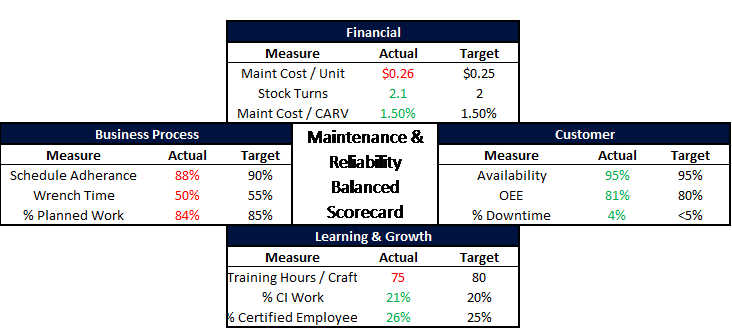Use a Balanced Scorecard to Ensure the Right Behaviours are Embedded in Your Organization
This post is the third of a miniseries on Key Performance Indicators (KPIs). If you haven’t already, please go back and read the first post on what is a KPI and the second post on leading Vs Lagging KPIs.
 As already discussed, KPIs can be a great tool to measure progress, predict future performance and hold personnel and teams accountable. In order to use KPIs to accomplish these objectives, the KPIs need to be aligned with the organization’s goals. However when cascading goals from the organization’s goals to the department and individual level one must be careful to avoid embedding the inappropriate behaviour. For example if the organization is focused on reducing costs, costs can be reduced in the short term by stopping all PM routines, but long term costs will certainly increase. This is not the intent of the organization’s goal, but may be a by-product of assigning a single goal to a department or individual. A balanced scorecard is design to alert managers if the organization is meeting expectations and prevent this inappropriate behaviour.
As already discussed, KPIs can be a great tool to measure progress, predict future performance and hold personnel and teams accountable. In order to use KPIs to accomplish these objectives, the KPIs need to be aligned with the organization’s goals. However when cascading goals from the organization’s goals to the department and individual level one must be careful to avoid embedding the inappropriate behaviour. For example if the organization is focused on reducing costs, costs can be reduced in the short term by stopping all PM routines, but long term costs will certainly increase. This is not the intent of the organization’s goal, but may be a by-product of assigning a single goal to a department or individual. A balanced scorecard is design to alert managers if the organization is meeting expectations and prevent this inappropriate behaviour.
The balanced scorecard ensures that the organization is meeting expectations across multiple perspectives. By using multiple perspectives the ability of the organization to balance and measure strategic short and long term goals is achieved. How is a balanced scorecard developed and designed for a maintenance department? The reminder of this post will walk through how to create a balanced scorecard for your department.
Balanced Scorecard Design
The balanced scorecard should focus on the strategy of the business and the maintenance department, by translating the vision into operational goals. Instead of including all of the KPIs or metrics, the balanced scorecard should consist of a few financial and non-financial KPIs. These select KPIs will ensure that the leadership can quickly review the performance, provide feedback and if necessary adjust the strategy. The KPIs will fall into one of the four perspectives.
The Four Perspectives
Financial: encourages the identification of a few relevant high-level financial measures that align with the business goals. These may include $/CARV, Maintenance Cost per Unit, Spares Cost /CARV, Stock Turns, etc.
Customer: encourages the identification of measures that answer the question “How do customers see us?” In the case of maintenance, the operations team is the customer. The KPIs selected need to reflect the service provided to them. These include % Downtime, Availability, Time to Process a Work Request, Schedule Adherence, etc.
Internal business processes: encourages the identification of measures that answer the question “What must we excel at?” These KPIs should reflect how well the maintenance process is functioning. The measures may include wrench time, schedule adherence, % of planned work, storeroom stock outs, etc.
Learning and growth: encourages the identification of measures that answer the question “How can we continue to improve”. This ensures the organization continues to improve, and may be measured by % of continuous improvement work, training hours per maintenance employee, % of accredited employees, etc.
Within each of the perspectives, numerous Maintenance KPIs can be utilized, so choosing the right KPIs can be difficult. Remember that the balanced scorecard is designed to ensure the short and long term goals of the business are accomplished, without driving inappropriate behaviour. Keeping this in mind, we need to remember Newton’s 3rd law, for every action, there is an equal and opposite reaction. If you translate this to Maintenance KPIs, it means that if we put in a financial measure that has the potential to drive inappropriate behaviour, we must put in an equal and opposite KPI to balance it. Keeping this in mind, a Maintenance & Reliability Scorecard will ensure all behaviours are aligned with the culture and vision of the business.
A Maintenance & Reliability Balanced Scorecard
To ensure maximum value is provided to business, a Maintenance & Reliability scorecard has been developed by Eruditio, LLC. This scorecard takes into account many of the variables within a manufacturing environment, regardless of industry, ensuring the business objectives are met. All targets will vary depending on the business goals, and as such, they should be adjusted to reflect the needs of the business. This scorecard has been made available for download to our readers, by clicking this link. The scorecard does not include the KPI definitions, however SMRP has an excellent resource on the definitions of the KPIs in their Best Practice Guidelines.
Figure 1 Maintenance Balanced Scorecard
If you already have a balanced scorecard, what KPIs are you using? If you don’t have one, did you try the one above and what results did you experience? I encourage you to share your stories, as everyone benefits from sharing.
Remember, to find success, you must first solve the problem, then achieve the implementation of the solution, and finally sustain winning results.
I’m James Kovacevic
Eruditio, LLC
Where Education Meets Application
Follow @EruditioLLC


would like to have the Maintenance & Reliability scorecard.